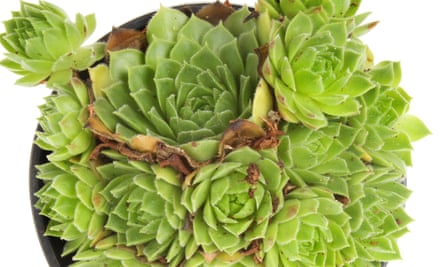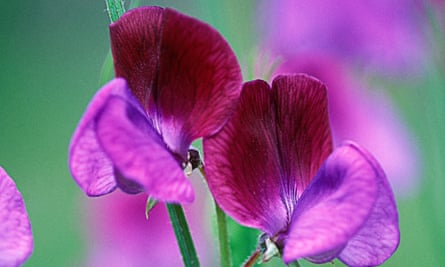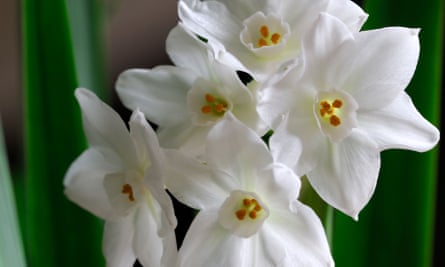Buy bulbs
Whether you buy in person or by mail-order, plan your spring bulb purchases now: the choicest selections always go fast, and you don’t want to be left with a sack of the gaudiest daffodils again (or was that just me?).
The Guardian’s product and service reviews are independent and are in no way influenced by any advertiser or commercial initiative. We will earn a commission from the retailer if you buy something through an affiliate link. Learn more.
It helps to have a colour scheme in mind first, though. This year, the bulb that epitomises the interiors trend for flesh tones is a tulip called ‘La Belle Epoque’. This is a peony-flowered type (that is, full and blowsy) that always turns heads on the Bloms Bulbs stand at the Chelsea flower show; Sarah Raven also loves it, describing the colour as “coffee mousse, flushed with pink”. If the flounce of that tulip is too much for you, try the May-flowering single ‘Pink Diamond’ or the April-blooming ‘Apricot Beauty’; and add drama by mixing them with the almost-black ‘Paul Scherer’, which should flower in late April/early May.
I love to include a novelty in my bulb order, and what better than a late spring bulb that doubles as an edible? This year I am adding bath asparagus (Ornithogalum pyrenaicum) to my collection of alternatives to actual asparagus. It has subtle, green flowers and grows to 50-60cm tall. Some sellers suggest drier soil, others moist; it will take a couple of years before I can start harvesting it, but I am convinced it will be worth the wait.
Plant winter pots

As summer bedding goes over, replace it with something a little more subtle and low-maintenance for winter. Rusty-toned heucheras complement smaller grasses such as Carex buchananii; then add dark red ajuga, silvery thymes or small-leaved ivies to tumble over the sides of the pot.
If you want something to sit on a table, plant up shallow terracotta trays, old cake tins or metal tool boxes with house leeks. As their Latin name suggests, sempervivum are incredibly tough – unlike their fellow succulents echeverias and aeoniums, they are hardy and will survive freezing temperatures, provided drainage is sharp. Mix one part horticultural grit to one part peat-free multipurpose compost for the planting mix, and punch holes in the bottom of any container you decide to upcycle. Top dress with grit or stones, to stop birds digging about and making a right old mess.
Get peas, please

Sweet pea breeding is a competitive business, yielding all kinds of new creations every year. If you have a cold frame or greenhouse, or even an unheated bright porch, sweet peas ordered now and sown next month will do well come next spring: try the colour-changing ‘Blue Shift’ and ‘Turquoise Lagoon’. After several attempts, I have come to the conclusion that the dark purple types such as ‘Almost Black’ look glamorous up close, but in the garden the impact of these moody blooms tends to be lost. So go instead for the bright red ‘Barry Dare’ or the stunning old favourite ‘Matucana’. Sweet peas do well when sown individually in seed compost in toilet roll inner tubes or root trainers. Once they’re growing strongly, pinch out the top just above a set of leaves, to prevent legginess, then transplant into growing spots in March.
Sort festive flowers

However much I want to deny the existence of Christmas at this time of year, I make time to put in an order for paperwhite narcissi this month. These specially prepared bulbs are “forced” to flower within six to eight weeks, so get your timing right and you’ll have a scented white centrepiece for your festive table. Pale and interesting ‘Ziva’ is widely available, or try the jolly orange and gold ‘Grand Soleil d’Or’. Plant a bowlful every couple of weeks from the end of the month to ensure a show throughout the gloomy winter months, including 25 December. (Take that, poinsettias.)
Go vertical
Once you’ve filled every bed or container with plants, the only way is up: consider bare walls and fences in your garden as an opportunity to expand your canvas. The obvious option is to plant something that will clamber up and inhabit the space, but bear in mind that this will require soil to plant into. And don’t presume you can just plonk a clematis or rose in a small pot at the base of a wall and the space will be covered in a year: more likely the plant will be dead.
Diligent watering is required, or better still a self-watering system, and choose the biggest pot you have space for (and can afford). You could prise up patio stones at the base of the bare wall, improve the soil and replace with organic matter and topsoil, but make sure plants are about 50cm from the base of the wall, and out of its “rain shadow”. Happily, the second half of this month is the ideal time to establish a clematis. I’ve got my eye on C. koreana ‘Amber’, a double creamy yellow type that flowers from early to midsummer and in September.
If you can’t accommodate a leafy cover-up, consider a nonliving alternative. To make walls and fences “disappear”, paint them black (try Ronseal Fence Life in Tudor Black Oak or Little Greene masonry paint in Basalt). Or decorate them: buy or make matching (or mismatching) wooden bird boxes or insect hotels, paint in different colours and hang them on the wall. Even a water butt can be an attractive feature: the 150-litre Rainbowl Flower butt (£195) includes a planting space on top.
Sow coriander

The window for sowing many crops is closing – but not all. Coriander is often thought of as a hot-climate crop, but it does well in cooler conditions, too: sowings earlier in the summer often bolt before you have a chance to harvest a single leaf. Start off a succession of short rows (or potfuls) from now until the start of October, protecting them with a cloche or horticultural fleece as the temperature drops, and you’ll enjoy a crop right through to the start of winter. Choose a variety breed for maximum leafage, such as ‘Leisure’ or ‘Slow Bolt’.
Reuse compost
As veg in containers and grow bags and summer bedding in pots and hanging baskets pass their sell-by dates, you may be wondering what to do with all that “spent” compost. Well, this is useful stuff, so for heaven’s sake don’t waste it: add a 3-4cm-deep layer to wormeries as a fruit-fly deterrent, or use it as a mulch on borders, to deter weeds and lock in moisture. Alternatively, set it aside and reuse when you plant up new containers for late summer and autumn, but rejuvenate it first with homemade compost, worm casts or well-rotted manure.
The best gardening gear to see you through the autumn
1 Claude birdfeeder, £11.99
One of the best ways to keep down pest numbers at this time of year is to encourage birds into your garden: the more bird feeders you have on the go, the better. This one has squirrel-proof wire mesh.
2 Hand brush, £8
This curved brush is ideal for tackling awkward spaces (the corner of the shed, say, or the areas under hard-to-move outdoor furniture).
3 Tube thermometer, £16.95
Keep an eagle eye on temperatures as autumn approaches, because sudden drops at night time can have a devastating effect on tender crops. This thermometer is suitable for positioning both outside in your garden and in the greenhouse.
4 Wire basket apple picker, £23
This tool is a boon for anyone with a fruit tree, or designs on harvesting from a tree in the street. The wire basket design allows you to pick fruit safely from ground level, and saves you having to risk life and limb by climbing up a rickety ladder. The wooden handle is 1.5m long, but if your fruit trees are particularly tall, it can be removed and replaced with a longer one.
5 Golden spade, £34
This general-purpose steel spade is strong, yet surprisingly light; its pointed blade makes it perfect for cutting through the ground when planting trees and shrubs.
6 Plant mister, £12.95
Misters are very useful for keeping humidity up and dust at bay on the leaves of orchids and other houseplants, but don’t use it on hairy-leaved specimens such as African violets.
7 Starburst seed saver envelopes, £7.50 for a set of eight
Use these paper envelopes to store any seed you’ve saved from the garden, be that tomatoes, nigella, pot marigolds or poppies.
8 Potting bench, £130
This may be just the thing you need to get your gardening workspace in order. It’s made of FSC pine and has an easy-to-clean zinc top.
9 Rusty rustic fire pit brazier, £59.95
Fire has always had amazing pulling power when it comes to getting people outside into the garden, even in cold weather. Light this brazier and you’ll soon have a small army of willing helpers – especially if you lay on some marshmallows for toasting on the flames.

Comments (…)
Sign in or create your Guardian account to join the discussion